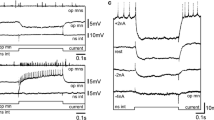Abstract
The possible existence of intrasynaptic ephaptic feedback in the invertebrate CNS was studied. Intracellular recordings were made of excitatory postsynaptic potentials and currents arising on activation of the recently described monosynaptic connection between identified neurons in the snail CNS. In the presence of ephaptic feedback, tetanization of the postsynaptic neuron with hyperpolarizing impulses should activate presynaptic calcium channels, thus increasing the amplitude of excitatory postsynaptic potential, while sufficiently strong postsynaptic hyperpolarization applied during generation of the excitatory postsynaptic current should induce “supralinear” increases in its amplitude, as has been observed previously in rat hippocampal neurons. The first series of experiments involved delivery of 10 trains of hyperpolarizing postsynaptic impulses (40–50 mV, duration 0.5 sec, frequency 1 Hz, train duration 45 sec); significant changes in the amplitude of excitatory postsynaptic were not seen. In the second series of experiments, changes in the amplitude of the excitatory postsynaptic current were studied during hyperpolarization of the postsynaptic neuron. At a potential of −100 mV, the amplitude of the excitatory postsynaptic current increased significantly more than predicted by its “classical” linear relationship with membrane potential. This “supralinear” increase in the amplitude of the excitatory postsynaptic potential can be explained by the operation of ephaptic feedback and is the first evidence for this phenomenon in CNS synapses of invertebrates.
Similar content being viewed by others
REFERENCES
P. M. Balaban, N. I. Bravarenko, L. L. Voronin, and P. V. Gusev, “Long-term potentiation in the central nervous system of the snail after intracellular tetanization,” Dokl. Ros. Akad. Nauk., 343, No.4, 563–566 (1996).
L. L. Voronin, “Intrasynaptic ephaptic feedback in central synapses,” Ros. Fiziol. Zh. im. I. M. Sechenova, 85, No.6, 729–742 (1999).
L. L. Voronin, M. A. Volgushev, M. V. Sokolov, A. S. Kas’yanov, and M. V. Chistyakova, “The effects of postsynaptic hyperpolarization support the existence of intrasynaptic ephaptic feedback in central synapses,” Dokl. Ros. Akad. Nauk., 369, No.1, 126–129 (1999).
S. V. Kul’chitskii, V. V. Maksimov, P. V. Maksimov, M. S. Lemak, and L. L. Voronin, “Correlation between paired responses supports the existence of positive ephaptic feedback in central synapses,” Dokl. Ros. Akad. Nauk., 389, No.1, 1–3 (2003).
N. Berretta, A. V. Rossokhin, E. Cherubini, A. V. Astrelin, and L. L. Voronin, “Long-term synaptic changes induced by intracellular tetanization of CA3 pyramidal neurones in hippocampal slices from juvenile rats,” Neurosci., 93, 469–477 (1999).
N. Berretta, A. V. Rossokhin, A. M. Kasyanov, M. V. Sokolov, E. Cherubini, and L. L. Voronin, “Postsynaptic hyperpolarization increases the strength of AMPA mediated synaptic transmission at large synapses between mossy fibres and CA3 pyramidal cells,” Neuropharmacology, 39, 2288–2301 (2000).
T. V. P. Bliss and G. Collingridge, “A synaptic model of memory: long-term potentiation in the hippocampus,” Nature, 361, 31–39 (1993).
N. J. Bravarenko, P. V. Gusev, P. M. Balaban, and L. L. Voronin, “Postsynaptic induction of long-term synaptic facilitation in snail central neurons,” Neuroreport, 6, No.8, 1182–1186 (1995).
A. L. Byzov and T. M. Shura-Bura, “Electrical feedback mechanism in the processing of signals in the outer plexiform layer of the retina,” Vision. Res., 26, 33–34 (1986).
D. S. Chesnoy-Marchais, “Characterization of chloride conductance activated by hyperpolarization in Aplysia neurones,” J. Physiol. (London), 342, 277–308 (1983).
A. M. Kasyanov, V. V. Maximov, A. L. Byzov, et al., “Intrasynaptic ephaptic feedback alters amplitude-voltage relations of mossy fibre responses in rat CA3 hippocampal neurones,” Neurosci., 101, No.2, 323–336 (2000).
U. Kuhnt, A. M. Kleschevnikov, and L. L. Voronin, “Long-term enhancement of synaptic transmission in the hippocampus after tetanization of single neurones by intracellular current pulses,” Neurosci. Res. Commun., 14, 115–123 (1994).
A. Y. Malyshev and P. M. Balaban, “Identification of mechanoafferent neurons in terrestrial snail: response properties and synaptic connections,” J. Neurophysiol., 87, No.5, 2364–2371 (2002).
A. Malyshev, N. Bravarenko, and P. Balaban, “Dependence of synaptic facilitation postsynaptically induced in snail neurons on season and serotonin level,” Neuroreport, 8, No.5, 1179–1182 (1997).
V. V. Maximov and A. L. Byzov, “Horizontal cell dynamics: what are the main factors?” Vision Res., 36, 4077–4087 (1996).
N. Spruston and D. Johnston, “Perforated patch-clamp analysis of the passive membrane properties of three classes of hippocampal neurons,” J. Neurophysiol., 67, No.3, 508–529 (1992).
N. Spruston, D. Jaffe, and D. Johnston, “Dendritic attenuation of synaptic potentials and currents: the role of passive membrane properties,” Trends Neurosci., 17, 161–166 (1994).
M. Volgushev, L. L. Voronin, M. Chistiakova, and W. Singer, “Induction of LTP and LTD in visual cortex neurones by intracellular tetanization,” Neuroreport, 5, 2069–2072 (1994).
M. Volgushev, L. L. Voronin, M, Chistiakova, and W. Singer, “Relations between long-term synaptic modifications and paired-pulse interactions in the rat neocortex,” Eur. J. Neurosci., 9, 751–760 (1997).
L. L. Voronin, “On the quantal analysis of hippocampal long-term potentiation and related phenomena of synaptic plasticity,” Neurosci., 56, 275–304 (1993).
L. L. Voronin, A. Byzov, A. Kleshevnikov, et al., “Neurophysiological analysis of long-term potentiation in mammalian brain,” Behav. Brain Res., 66, 45–52 (1995).
L. L. Voronin, M. Volgushev, M. Sokolov, et al., “Evidence for an ephaptic feedback in cortical synapses: postsynaptic hyperpolarization alters the number of response failures and quantal content,” Neurosci., 92, No.2, 399–405 (1999).
R. I. Wilson and R. A. Nicoll, “Endocannabinoid signaling in the brain,” Science, 296, 678–682 (2002).
Author information
Authors and Affiliations
Additional information
__________
Translated from Zhurnal Vysshei Nervnoi Deyatel’nosti imeni I. P. Pavlova, Vol. 54, No. 4, pp. 565–572, July–August, 2004.
Rights and permissions
About this article
Cite this article
Bravarenko, N.I., Malyshev, A.Y., Voronin, L.L. et al. Ephaptic Feedback in Identified Synapses in Mollusk Neurons. Neurosci Behav Physiol 35, 781–787 (2005). https://doi.org/10.1007/s11055-005-0124-z
Received:
Accepted:
Issue Date:
DOI: https://doi.org/10.1007/s11055-005-0124-z




